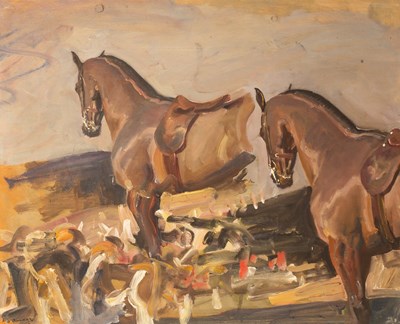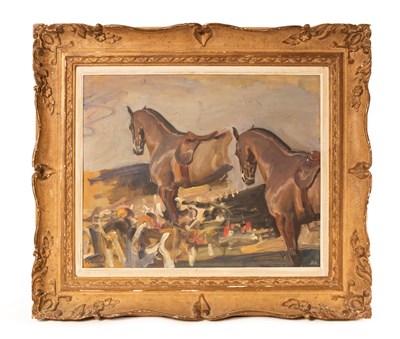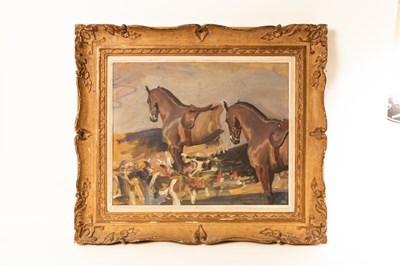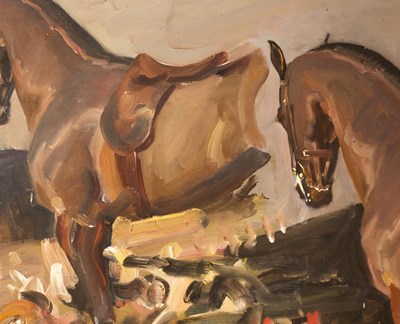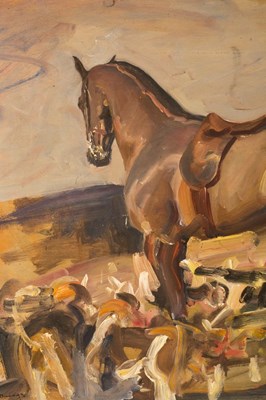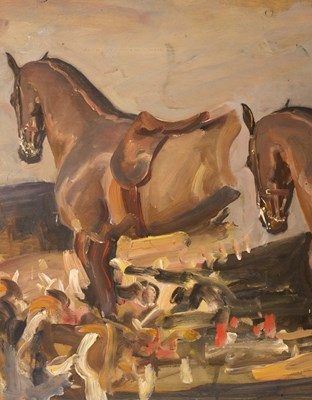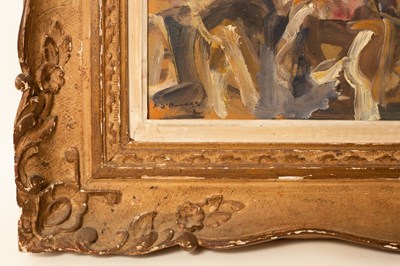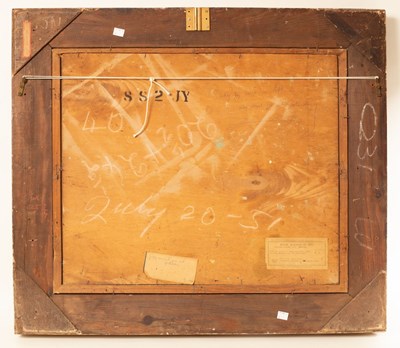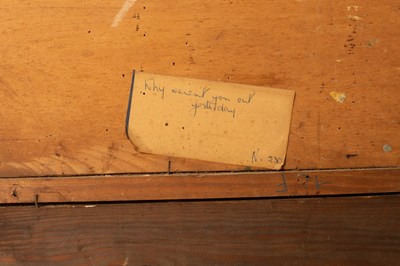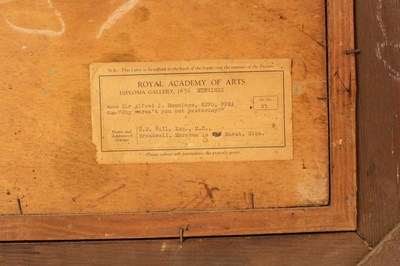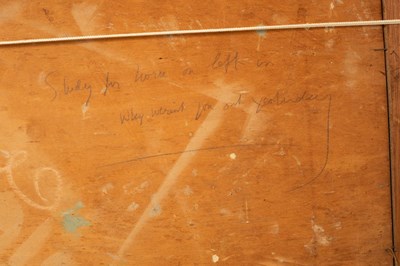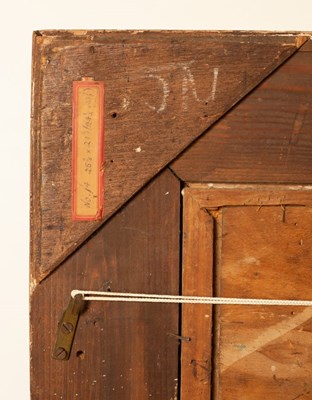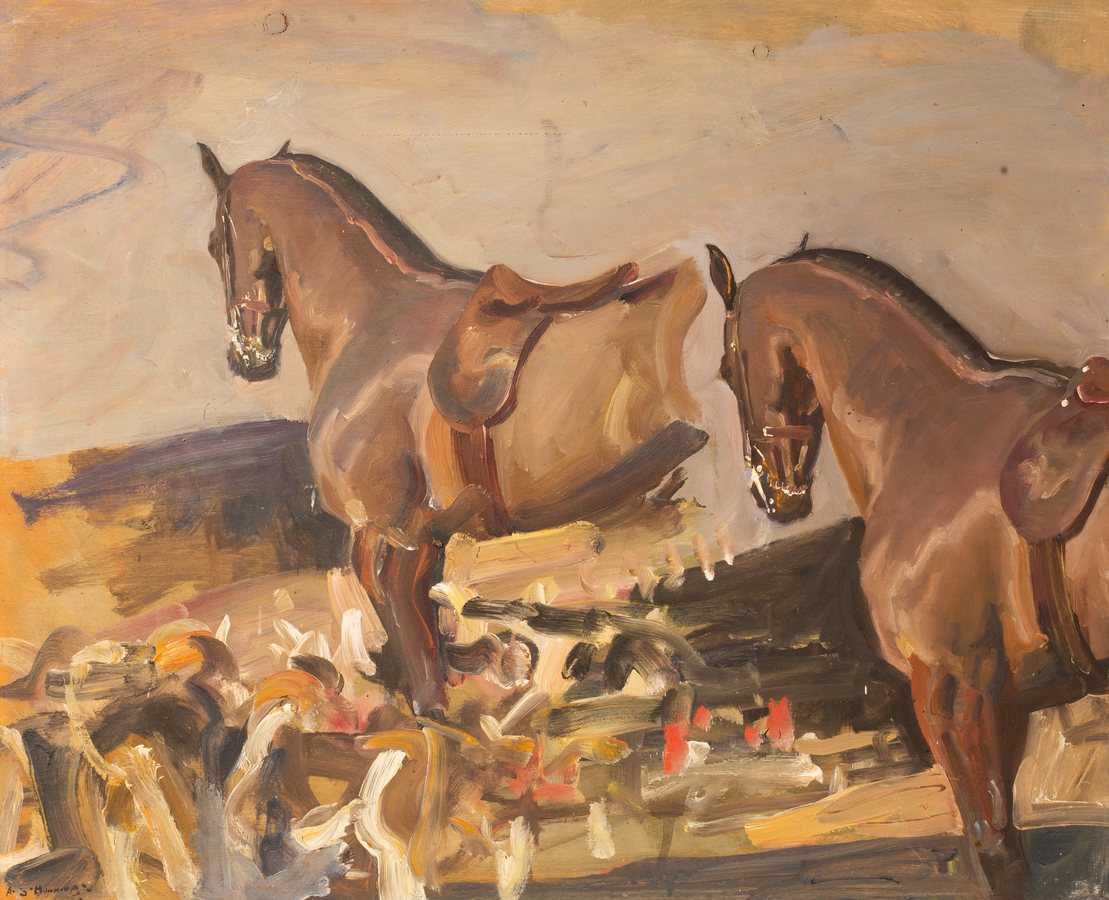5th Dec, 2022 14:00
19th & 20th Century Paintings
5
Sir Alfred James Munnings, PRA, RI (1878-1959)/Study For A Horse/signed AJ Munnings lower left/inscribed verso 'study for a horse on left in Why weren't you out yesterday'/oil on board, 48.25cm x 59.5cm/Provenance: An Important Collection of Sporting Pictures sold by order of Messrs. Hutchinson & Co. (Publishers) Limited; Christies, London, 20 July 1951, lot 40 (sold for £105) H.B. Hill, Esq., Gloucester/Exhibited: London, Royal Academy of Arts, Diploma Gallery, 1956, no.45/Note: A preparatory study for 'Why weren't you out yesterday', which was exhibited at the Royal Academy in 1939, five years before Munnings was elected President. One of Munnings' most humorous works (and featuring his wife, Violet, a family-friend, and four of his own horses), 'Why weren't you out yesterday' was based on a portrait of Mrs Cutting and her daughters, members of a prominent New Jersey family, painted in 1935. Munnings said 'so taken I was with the arrangement that I repeated almost the same design on another canvas for my own amusement'. In preparation for larger scale paintings, Munnings would produce studies to test, and figure out elements of each composition. The present work shows the artist doing exactly this, which affords the viewer an insight into his creative process. It is likely that Munnings would have painted the central hunter first, as the one to the right is a more worked-up version, with re-considered elements such as the angle of the head, and twitch of the left ear (communicating the horse's state of alert), both of which feature in the final painting. The hounds have been created with a quick succession of brush strokes that capture the energy and movement of the pack: light brown insinuates heads and rumps, and dashes of white create wagging tails. The red from the huntsmen's jackets beyond, breaks up the composition, a device which John Constable, a fellow Suffolk artist much admired by Munnings, also employed, particularly in his landscapes. The grey beyond strengthens the silhouettes and forms of the hunter and is a colour test for the sky of the final composition. It has been speedily executed with a gradation of colours and a 'zigzag' to the left, giving the implication of a cloud formation. Spontaneity, immediacy, understanding and above all, enjoyment are apparent in this study, and it captures Munnings returning, as he did throughout his life, to two of his greatest passions: horses and hunting. Our thanks go to Tom Rooth for producing this catalogue note
Sold for £74,000
Sir Alfred James Munnings, PRA, RI (1878-1959)/Study For A Horse/signed AJ Munnings lower left/inscribed verso 'study for a horse on left in Why weren't you out yesterday'/oil on board, 48.25cm x 59.5cm/Provenance: An Important Collection of Sporting Pictures sold by order of Messrs. Hutchinson & Co. (Publishers) Limited; Christies, London, 20 July 1951, lot 40 (sold for £105) H.B. Hill, Esq., Gloucester/Exhibited: London, Royal Academy of Arts, Diploma Gallery, 1956, no.45/Note: A preparatory study for 'Why weren't you out yesterday', which was exhibited at the Royal Academy in 1939, five years before Munnings was elected President. One of Munnings' most humorous works (and featuring his wife, Violet, a family-friend, and four of his own horses), 'Why weren't you out yesterday' was based on a portrait of Mrs Cutting and her daughters, members of a prominent New Jersey family, painted in 1935. Munnings said 'so taken I was with the arrangement that I repeated almost the same design on another canvas for my own amusement'. In preparation for larger scale paintings, Munnings would produce studies to test, and figure out elements of each composition. The present work shows the artist doing exactly this, which affords the viewer an insight into his creative process. It is likely that Munnings would have painted the central hunter first, as the one to the right is a more worked-up version, with re-considered elements such as the angle of the head, and twitch of the left ear (communicating the horse's state of alert), both of which feature in the final painting. The hounds have been created with a quick succession of brush strokes that capture the energy and movement of the pack: light brown insinuates heads and rumps, and dashes of white create wagging tails. The red from the huntsmen's jackets beyond, breaks up the composition, a device which John Constable, a fellow Suffolk artist much admired by Munnings, also employed, particularly in his landscapes. The grey beyond strengthens the silhouettes and forms of the hunter and is a colour test for the sky of the final composition. It has been speedily executed with a gradation of colours and a 'zigzag' to the left, giving the implication of a cloud formation. Spontaneity, immediacy, understanding and above all, enjoyment are apparent in this study, and it captures Munnings returning, as he did throughout his life, to two of his greatest passions: horses and hunting. Our thanks go to Tom Rooth for producing this catalogue note
Auction: 19th & 20th Century Paintings, 5th Dec, 2022
